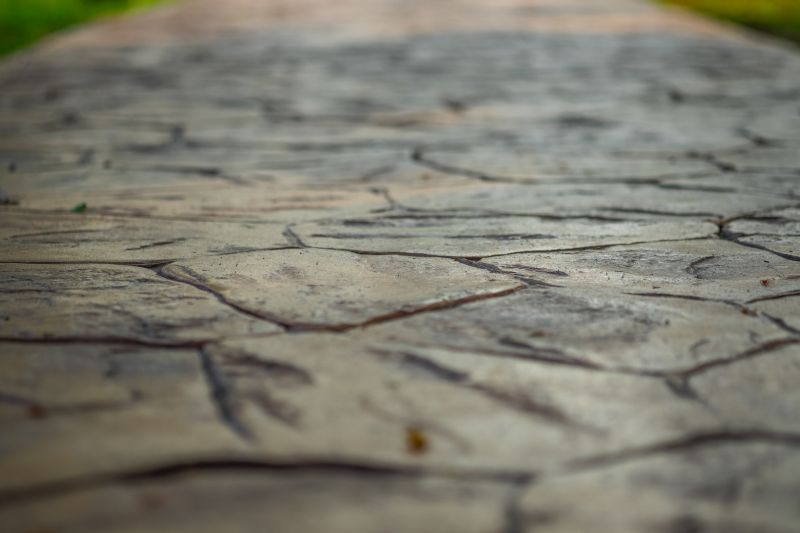Favorite Equipment for Stamped Concrete Service Projects
Learn about the most trusted products used by professionals to create stunning stamped concrete surfaces.
 Stamped concrete service offers a versatile and aesthetically appealing way to enhance various outdoor surfaces. This technique involves applying color and texture to concrete to mimic the appearance of natural materials such as stone, brick, or slate. It is commonly used for patios, walkways, driveways, and pool decks, providing a durable and low-maintenance alternative to traditional paving options. The process typically involves pouring concrete, followed by stamping patterns into the surface while it is still workable, then sealing it to protect against wear and weathering.
Stamped concrete service offers a versatile and aesthetically appealing way to enhance various outdoor surfaces. This technique involves applying color and texture to concrete to mimic the appearance of natural materials such as stone, brick, or slate. It is commonly used for patios, walkways, driveways, and pool decks, providing a durable and low-maintenance alternative to traditional paving options. The process typically involves pouring concrete, followed by stamping patterns into the surface while it is still workable, then sealing it to protect against wear and weathering.
Top Overall Option
Concrete Stamping and Coloring Kit
A comprehensive kit that includes a variety of stamping mats, color hardeners, release agents, and sealers, designed to provide flexibility and consistency for stamped concrete projects. Suitable for both DIY enthusiasts and professional contractors, it offers a range of textures and colors to create customized finishes that enhance outdoor spaces.
Types of Products For Stamped Concrete Service
Stamping Mats
Flexible rubber mats with patterns that imprint textures onto freshly poured concrete, mimicking natural stones, bricks, or other surfaces.
Color Hardeners
Powdered pigments applied to concrete to add vibrant, durable color that enhances stamped patterns.
Release Agents
Non-stick substances applied to stamping mats to prevent sticking and ensure clean pattern transfer.
Integral Color Additives
Colorants mixed directly into the concrete mix for uniform coloration throughout the surface.
Concrete Sealers
Protective coatings that seal the stamped surface, enhancing appearance and resistance to stains and weathering.
Acid Stain
Chemical stains used to create variegated, mottled color effects on stamped concrete.
Polymer Modifiers
Additives that improve the flexibility and durability of stamped concrete surfaces.
Texturing Tools
Hand-held tools used to add additional textures or refine stamped patterns.
Color Sprays
Sprayable color products that provide accents and highlights on stamped concrete.
Clear Sealers
Transparent coatings that preserve the color and pattern while providing a protective barrier.
Polyurethane Sealers
High-gloss or matte sealers offering increased durability and UV resistance.
Epoxy Coatings
Resilient coatings that can be applied over stamped concrete for additional protection and aesthetic effects.
Stencil Patterns
Pre-cut templates used to add intricate designs or borders to stamped surfaces.
Glow-in-the-Dark Pigments
Specialty additives that enable stamped concrete to glow in low-light conditions.
Anti-Slip Additives
Materials incorporated into sealers to improve traction on stamped surfaces.
Popular Choices
Variety of patterns that replicate natural stone, brick, and slate textures, widely used for decorative concrete projects.
Popular for adding vibrant, durable color to stamped concrete surfaces.
Essential for clean pattern transfer and preventing mats from sticking during stamping.
Commonly used to protect and enhance the appearance of stamped concrete.
Favored for consistent, uniform coloration throughout the concrete mix.
Preferred for their high durability and glossy finish options.
Chosen for creating unique, variegated color effects on stamped surfaces.
Popular for customizing and refining stamped patterns on-site.
Used for adding accents or highlights to stamped concrete.
Trending for creating illuminated outdoor features.
Increasingly used for safety, especially in wet areas.
Selected for enhancing the flexibility and lifespan of stamped surfaces.
In Poulsbo, WA, homeowners and contractors often choose stamped concrete for its ability to add visual interest and value to outdoor spaces. The variety of patterns and color options allows for customization to match architectural styles and personal preferences. Proper preparation and sealing are essential to ensure longevity and maintain the appearance of the stamped surface. When selecting products for stamped concrete, it is important to consider compatibility with existing concrete, ease of application, and the level of protection offered against environmental factors.
The right products can significantly influence the final look and durability of stamped concrete projects. From coloring agents to stamping mats and sealers, each component plays a role in achieving the desired aesthetic and performance. Investing in quality supplies can help ensure the project meets expectations and withstands the test of time. Whether working on a small residential driveway or a large commercial plaza, choosing appropriate products tailored to your specific needs is crucial for success.
Key Buying Considerations
- Compatibility of products with existing concrete and project requirements.
- Type of pattern or texture desired and available stamping mats.
- Color options and whether to use integral color or surface-applied pigments.
- Durability and weather resistance of sealers and coatings.
- Ease of application and whether professional assistance is recommended.
- Level of slip resistance needed, especially for outdoor or wet areas.
- Protection against UV rays to prevent fading over time.
- Compatibility of release agents with stamping mats and concrete mix.
- Environmental conditions during application, such as temperature and humidity.
- Desired finish—matte, satin, or high-gloss—and corresponding sealers.
- Budget constraints and cost-effectiveness of product combinations.
- Availability of product support and technical guidance.
- Long-term maintenance requirements for stamped surfaces.
- Safety features, like anti-slip additives, for high-traffic areas.
- Compatibility with decorative accents or additional coloring techniques.
